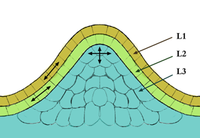
Photo from wikipedia
Lateral roots (LRs) determine the overall root system architecture, thus enabling plants to efficiently explore their underground environment for water and nutrients. However, the mechanisms regulating LR development are poorly… Click to show full abstract
Lateral roots (LRs) determine the overall root system architecture, thus enabling plants to efficiently explore their underground environment for water and nutrients. However, the mechanisms regulating LR development are poorly understood in monocotyledonous plants. We characterized a rice mutant, wavy root elongation growth 1 (weg1), that produced higher number of long and thick LRs (L-type LRs) formed from the curvatures of its wavy parental roots caused by asymmetric cell growth in the elongation zone. Consistent with this phenotype, the expression of the WEG1 gene, which encodes a putative member of the hydroxyproline-rich glycoprotein family that regulates cell wall extensibility, was specifically localized in the root elongation zone. The asymmetric elongation growth in roots is well known to be regulated by auxin, but we found that the distribution of auxin at the apical region of the mutant and the wild-type roots was symmetric suggesting that the wavy root phenotype in rice is independent of auxin. However, the accumulation of auxin at the convex side of the curvatures, the site of L-type LR formation, suggested that auxin likely induced the formation of L-type LRs. This was supported by the need of a high amount of exogenous auxin to induce the formation of L-type LRs. These results suggest that the MNU-induced weg1 mutated gene regulates the auxin-independent parental root elongation that controls the number of likely auxin-induced L-type LRs, thus reflecting its importance in improving rice root architecture. This article is protected by copyright. All rights reserved.
Journal Title: Physiologia plantarum
Year Published: 2020
Link to full text (if available)
Share on Social Media: Sign Up to like & get
recommendations!